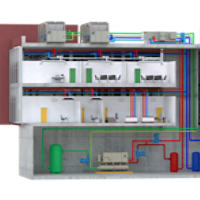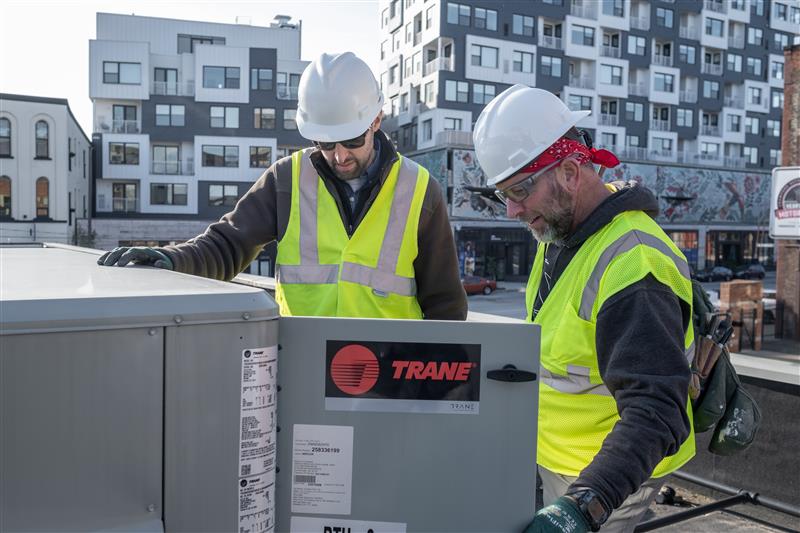Webinar
Building Pressure Control Engineers Newsletter LIVE
In this program, we will review the factors that influence building pressure. We will also explain how HVAC system operation can impact ventilation airflow rates, exhaust rates, and the resulting building pressure. Then we will demonstrate and discuss several common building pressure control techniques and controls using a model building. Finally, we will review several industry standard requirements related to building pressure control.

Quick Facts
- Topics
- Engineers Newsletter

Building pressure control is often overlooked, but it can have a significant impact on building operation. Poor building pressure control can result in damage to the building envelope, poor indoor air quality, or an increase in HVAC energy use.
In this program, Trane applications engineers will review the factors that influence building pressure and explain how HVAC system operation can impact ventilation airflow rates, exhaust rates, and the resulting building pressure. They’ll demonstrate and discuss several common building pressure control strategies using a model building. And finally, they will review several industry requirements related to building pressure control.
Presenters: Chris Hsieh, Eric Sturm and John Murphy
After viewing attendees will be able to:
- Recognize that multiple factors, such as HVAC, weather, and wind impact building pressure.
- Understand that airside economizing alters the amount of outdoor air entering the building and the exhaust system must also adjust its airflow rate to maintain building pressurization.
- Understand the drawbacks of using barometric relief dampers in systems equipped with airside economizers.
- Explain the benefits of direct measurement and control of building pressure.
- Understand the differences between a return fan and a relief fan.
Location: Virtual - GoToWebinar
Fees: No Cost
Earn: 1.0 PDH to fulfill GBCI, Professional Engineer (PE)*, or AIA credential requirements.
*This presentation is not registered with any state. Check state continuing education requirements if credit can be applied.
Speaker
-

Chris Hsieh
Chris has been with Trane since 1996. His ongoing charter includes system applications support, industry-related green/environmental programs such as ENERGY STAR®, LEED, and ASHRAE 189.1 as well as IAQ initiatives. Chris volunteers to serve on ASHRAE®’s SSPC 189.1, SSPC 145, various TCs, and the ASHRAE La Crosse Chapter. Chris also assisted LEED EB (Silver) certification for Trane St. Paul building and LEED NC (Gold and Certified) certifications for Trane Taicang office and facility buildings. He is a LEED-AP BD+C, Certified Energy Manager, UL Environment DfS (Design for Sustainability) Gold certified, and ASHRAE member.
Chris is passionate about youngsters’ education. To increase Trane’s local community involvement and focus on STEM education, Chris has volunteered to serve as a math club team coach for a local middle school since 2018 - which advanced to the Wisconsin State competition in 2019, 2020, and 2021.
-

John Murphy
John has been with Trane since 1993, where he has been involved in development, training, and support activities related to HVAC systems. His primary responsibility as an applications engineer is to aid system design engineers and Trane sales personnel in the proper design and application of HVAC systems. John is the author of numerous Trane application manuals and Engineers Newsletters, and is a frequent presenter on Trane’s Engineers Newsletter Live program series.
He is an ASHRAE® Fellow and past chair of that society’s “Mechanical Dehumidifiers” technical committee. He has authored many articles for the ASHRAE Journal, twice receiving the best Journal article award (2011 and 2012). He is a frequent speaker at conferences and was a featured presenter on ASHRAE’s international webcast, “Dedicated Outdoor Air Systems.” He was a contributing author of the Advanced Energy Design Guide for K-12 Schools and the Advanced Energy Design Guide for Small Hospitals and Health Care Facilities, and a technical reviewer for the ASHRAE Design Guide for Dedicated Outdoor Air Systems, the ASHRAE Guide for Buildings in Hot and Humid Climates, and ASHRAE’s HVAC Design Manual for Hospitals and Clinics.
-

Eric Sturm
Eric joined Trane in 2006 after graduating from the University of Wisconsin – Platteville with a Bachelor of Science degree in mechanical engineering. Prior to joining the applications engineering team, he worked in the Customer Direct Services (C.D.S.) department as a marketing engineer and product manager for the TRACE™ 700 load design and energy simulation application. As a C.D.S. marketing engineer he supported and trained customers globally.
In his current role as an applications engineer, Eric’s areas of expertise include acoustics, airside systems, indoor agriculture, and indoor air quality. He is currently involved with ASHRAE® as a representative on Members Council and member of the indoor agriculture and sound and vibration technical committees. Eric is the recipient of the ASHRAE Distinguished Service Award and Young Engineers in ASHRAE Award of Individual Excellence.





